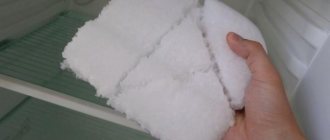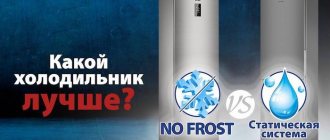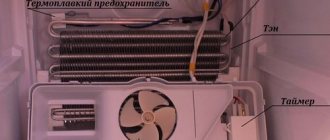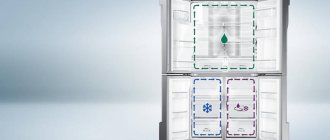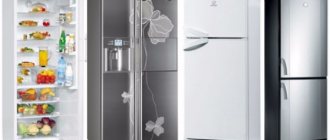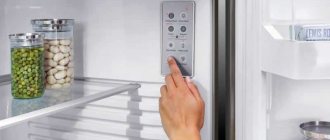In recent years, refrigerators equipped with the No Frost system have become very popular. Advertising played a significant role in this, claiming that such units do not require regular manual defrosting. However, this statement is only partly true, since in order to carry out general cleaning in the chambers, periodic defrosting of the No Frost refrigerator will be required. In addition, the refrigerator must be defrosted during routine inspections, while the ventilation system is being cleaned, to troubleshoot problems.
Automatic defrosting of the No Frost refrigerator
Frost-free operation (as the name of the technology is translated) is ensured by air circulating through the chambers, supplied by a built-in fan. The evaporator is removed from the chamber to the rear wall of the unit. The air flow, passing through the evaporator, cools and passes into the chambers.
Having given off heat, it returns along with water vapor to the evaporator, on the cold surface of which moisture settles in the form of condensate, which forms frost when it freezes. 2 - 3 times a day, during compressor stops, the ice is melted by an electric heater and removed outside. The appearance of ice on the walls is possible when the door is opened frequently, if it remains open for a long time, or due to a defect in the seal.
On Japanese and South Korean models (Samsung, LG), such a defrosting system is installed in both chambers. This is due to the high air humidity in these countries due to their proximity to the sea, and the No Frost refrigerator copes well with this problem. European manufacturers produce similar models (for example, from Stinol), but there are also combined models in which the freezer is equipped with No Frost, and the refrigerator compartment is equipped with a drip system.
How often should it be
Many users are interested in how often they need to defrost a Samsung No Frost refrigerator. It is recommended to unplug the device and clean the compartments every 6-12 months. The frequency of defrosting depends on the design features of the refrigeration unit. The indicator is calculated based on the device testing results. The parameter is indicated in the technical data sheet of the product.
You should also pay attention to the presence of ice. When a thick ice crust forms, the circulation of the refrigerant is disrupted. The compressor begins to work continuously, which leads to rapid wear of some parts of the device. When ice appears, you should not wait the required 6 months. You need to defrost the No Frost LG refrigerator immediately.
Operating principle of drip defrosting
In refrigerators with drip defrost, the evaporator is located on the back side of the back wall of the chamber. Therefore, it is colder than other surfaces and, in accordance with the laws of physics, moisture contained in the air condenses on it. During operation of the compressor, it forms ice, which, after stopping, begins to melt and flows drop by drop into the outer container. Simplicity and the absence of additional devices make this system very reliable. The main disadvantage is the inability to work in the freezer.
How to get rid of unpleasant odors?
The appearance of unpleasant odors in the device is most often associated with improper storage of products (failure to comply with product rules, storage of spoiled food, etc.).
To get rid of the “aroma,” first of all, find out and eliminate the cause of its occurrence.
The following methods will help eliminate strong odors from the refrigerator:
- mix vinegar and water in equal proportions and wash the inner walls of the chamber;
- crush 20-30 tablets of activated carbon, pour it onto plates or into gauze bags, place the product inside the refrigerator;
- crushed citrus peels (lemon, orange), black tea, sugar, rice, vanilla, coffee beans (grind them first) “absorb” various aromas well: as in previous cases, place the products in bags made of linen fabric, gauze, put inside a household devices.
Special balls for refrigerators, which are sold in household chemical stores, effectively eliminate even the most pungent odor.
The mineral components they contain destroy the unpleasant “amber” and prevent the appearance of mold. The balls are effective for 3-4 months; after this period, the drugs should be replaced with new ones.
ADVICE! Don't forget to take care of the device if you need to leave for a long time: defrost, wash the device and leave it unplugged, with the door open.
Carry out periodic checks of the products in the unit, throw away food that has expired, store food in special containers closed with a lid.
Cleanliness in the refrigerator is not only the key to your health, but also to the long life of your kitchen appliances.
Advantages and disadvantages of No Frost
The advantages of the system include:
- When used correctly, refrigerators with this technology ensure frost-free operation, so you need to defrost a No Frost refrigerator much less frequently than similar models with manual or drip defrosting.
- Due to the uniform temperature distribution inside the chamber, high quality freezing is ensured on all shelves.
- Another advantage is the ability to quickly restore the set temperature after loading a large number of products into the chamber. The packaging of the products does not freeze together.
- To ensure that greens and berries remain fresh for a long time, most refrigerators of this type have special compartments for storing them, where the temperature is maintained at 0C.
The disadvantages include:
- Dehydration of stored foods, but if you store them in airtight containers or wrap them in film, this will not happen.
- Since space is allocated for the system, No Frost refrigerators have 20% less chamber volume than similar models of other types.
- When the fan and compressor operate simultaneously, the noise level is high. However, manufacturers claim that the latest models operate virtually silently.
- Additional electricity is consumed to operate the fan.
- The cost is higher than that of drip analogues. But if you choose models from a line of the same level, the difference will not exceed 7 - 12%.
- Installed fans and automation that are prone to breakdowns reduce reliability. However, even if the system fails, the unit, even if not at full capacity, will continue to work, waiting for the breakdown to be repaired.
What not to do and why?
Rules that must not be broken:
It is not recommended to use vinegar to wash the seal. A highly concentrated solution is especially dangerous. It can cause the rubber to lose its elasticity.- If you do not plan to defrost the refrigerator, then you should not open the freezer while cleaning.
- Do not attempt to scrape off dried food debris with a knife, blade or other sharp instrument.
- Before any washing of the refrigerator (with or without defrosting), it must be disconnected from the power supply to avoid electric shock.
- Before placing the glass shelf under running hot water, you need to wait until it warms up. Otherwise the part may burst. Boiling water should not be used.
Sources
- https://www.miodimore.ru/kak-ochistit-kondensator-u-holodilnika/
- https://techforhome.ru/chistka-kondensatora-holodilnika
- https://kuhniug.ru/bytovaya-tehnika/chistka-holodilnika-nou-frost.html
- https://yborka.online/tehnika/holodilnik/kak-myt/no-frost
- https://domibit.ru/byt/uhod/kak-myt-holodilnik-nou-frost/
Do you want to understand better than others?
- How long can fish be stored in the freezer and refrigerator - When buying fish, we want to be sure of its quality, because good ingredients are the basis of a tasty and healthy dish. The second important point in cooking is the correct…
- What you need to know about the Low Frost system - When buying a modern refrigerator, many do not understand what the term Low Frost means, indicated in the characteristics of the freezer. This type of defrosting technology was...
- Built-in refrigerators from the manufacturer AEG with No Frost: characteristics of the models - German appliances for any purpose, including household ones, are highly valued all over the world. High-tech refrigeration equipment is the main principle of the AEG brand, which was...
- Top 3 best two-chamber Pozis refrigerators with No Frost system: detailed review - No Frost is a system designed to prevent the formation of ice and frost. Full no frost implies that this type of work applies to both refrigeration and…
- LG No Frost refrigerator with bottom freezer: 20 photos + instructions - Refrigerator LG GA-B509CEWL / GA-B459CEWL / GA-B509MMQZ / GA-B509MESL / GA-B459MMDZ / GA-B459MMQZ / GA-B459MESL / GA-B509CEQZ / GA- B509CESL / GA-B509CECL / GA-B459CESL /…
How to properly defrost a refrigerator with No Frost
The debate about how often you need to defrost the refrigerator still continues, but both sides agree that this procedure should be carried out at least once a year to do general cleaning. The most important thing is that you should not turn on the refrigerator immediately after cleaning and cleaning!
If at least a couple of hours do not pass after the shutdown, the compressor motor will be overloaded upon startup and will fail!
- Defrosting should be carried out in a cool environment so as not to damage the unit due to a sudden temperature change. If circumstances force you to defrost in hot weather, it is better to postpone the procedure to the evening or night hours.
- How long you need to keep the refrigerator turned off will depend on the circumstances. A day is considered optimal, but if necessary, 12 hours is enough. This is required to reduce the pressure in the refrigerant circulation system.
- Refrigerators with separate cooling systems have the ability to turn off the chambers. Therefore, they can be processed sequentially, first, for example, the disconnected refrigerator compartment, then the freezer. In models with one cooling circuit, it is impossible to do without defrosting both compartments at the same time.
Refrigerator with no frost function ATLANT XM 4524-060 ND.
Defrosting a refrigerator with a no frost system is carried out in the following sequence :
- After disconnecting from the power supply, food supplies are unloaded from the refrigerator.
- Removable elements, shelves, containers are removed. They are washed from dirt and dust with liquid detergent and set to dry.
- If there is a coating of frost on the walls, you cannot scrape it off with sharp objects so as not to damage the surface. It's better to let it thaw. To speed up the process, defrost using a hair dryer. Then, using a dry cloth, remove debris from the chamber and blot off the condensation.
- Surfaces are washed with soapy water, moistening a sponge or rag in it. To get rid of unpleasant odors, use a soda solution. To remove mold and mildew from the door seal, use lemon juice or ammonia. To wash the inside of the refrigerator and removable elements, do not use aggressive detergents, as their particles can get on the food, and the use of abrasive brushes and powders will damage the coating
- The ventilation holes of the system are cleaned with cotton swabs soaked in a soda solution. It is prepared at the rate of 2-3 tbsp. l. powder per 0.5 liters of water. You should not install ventilation grilles, as this will entail refusal of warranty repairs, regardless of the type of malfunction.
- Now you need to go over the surfaces with a sponge soaked in clean water and wipe them with a clean cloth.
- To complete general cleaning, the unit is moved away from the wall and the rear is cleared of accumulated dust deposits. And housewives don’t need to be taught how to clean the outside of a refrigerator.
- The doors open and the unit is left alone for the time specified above.
- At the end of the period, the containers and shelves are put in place, the doors are closed and the clean refrigerator is put into operation. After half an hour, the loading of products in full begins.
Helpful tips for defrosting
There are several other important factors that are important to observe when defrosting:
- Room air temperature. It is better to clean the chamber in the cool season, then the products that took up space on the shelves will last much longer without refrigeration.
- The defrosted refrigerator is turned on no earlier than after 15 minutes. Switching on abruptly will affect performance.
- When there is a power outage, household appliances begin to work worse. The refrigerator will have to be defrosted at least once every 4 months.
- Keep drawers, containers and shelves clean. Do not allow dirt and dust to accumulate, immediately remove food residues and wipe off stains.
Remember! Only cooled food can be placed in the refrigerator; cooked food must be covered with a lid or stored in containers.
Recommendations for using the system
To avoid having to deal with unscheduled defrosting, get into the habit of following simple rules:
- Clean up debris and spilled liquids immediately upon occurrence;
- Do not place food into the chamber that has not cooled down to room temperature. In principle, No Frost will cool them down, but you should not test the refrigerator's endurance.
- Products must be stored in airtight packaging.
- Do not load food into the chambers that does not require refrigeration.
When following the debate about whether it is necessary to defrost a No Frost refrigerator, it is worth listening to the opinion of the side advocating systematic care. Still, a clean, pleasant-smelling unit looks better than a smelly, dirty box. When you look at it, the question arises: can it be used to store food without harm to health?
How to eliminate odor in a camera
To get rid of the unpleasant stench, which is often caused by spoiled foods or food with a specific aroma, you can use several methods:
- Rinse the refrigerator with lemon juice and do not rinse it off with clean water.
- Place a small container of baking soda on the shelf. It is an effective sorbent. Within a day there will be no trace of the smell left.
- Use special odor absorbers. These include gel beads, various dispensaries, and an indicator egg. The latter, by the way, has two functions: it absorbs aromas and signals a decrease or increase in temperature in the chamber by changing color.
Refrigerator Stinol RF 345 A
Refrigerator Stinol RF 345 A 008 is a brand of refrigerator where the refrigerating chamber is equipped with a “drip” evaporator, here defrosting occurs automatically. When the compressor turns off, the frost on the surface of the evaporator melts. And then it flows in drops through the drain hole into the condensate tray. There is no No Frost system in this refrigerator. The freezer compartment is defrosted manually. The refrigerator compartment can be cleaned and washed once a year, as it gets dirty.
The video shows all the details of defrosting and washing the refrigerator:
General defrosting and cleaning of the refrigerator.
Preparing for cleaning at home
Before you start cleaning the No frost refrigerator, you need to prepare it. This process includes the following steps:
The temperature regulator in the device is set to zero;- a rag is placed next to the door;
- disconnect equipment from the power supply;
- remove all food from the refrigerator;
- remove shelves, drawers, pallets, grates - all elements that can be detached are best washed separately;
- leave the freezer open and wait for the ice to disappear;
- accumulated water is collected with a sponge.
To assess the thickness of the ice layer, you can remove the back wall of the freezer. If it is thick, this indicates either improper operation of the device or a malfunction in its operation.
Reasons for the formation of ice on the walls of the refrigerator
The precursor to frost and ice is condensation, which falls on the surface and freezes. Problems arise due to the following reasons:
- Equipment doors remain open for a long time.
- Wear of the sealing rubbers leads to a loose fit to the body.
- Placing hot foods in the refrigerator.
- Storing liquids in open containers.
- Low temperature values on the regulator.
Ice also appears on the walls due to technical faults. If the solenoid valve, which is responsible for regulating the cooling, fails. Problems can be caused by blockage in the capillary pipeline, breakdown of the defrost sensor and compressor overload.
Important!
The appearance of ice is especially dangerous for modern units with a drip system. Condensation appears on the walls regularly, but there should be no ice.
Where to start cleaning?
Start cleaning the refrigerator only after it has defrosted:
- set the thermostat to position “0”, disconnect the device from the network;
- lay old towels on the floor around the refrigerator, open the door of the device and fix it in this form;
- remove food from the refrigerator and place it in a cool place;
- remove all removable elements (shelves, drawers), wash them in soapy water, rinse and leave to dry;
- remove the moisture formed during the defrosting process and begin washing the device.
IMPORTANT! If both refrigerator compartments are equipped with a know-frost system, you can defrost and wash them either simultaneously or alternately.
Find out more about defrosting a two-compartment Bosch refrigerator. Read about how to defrost a Stinol two-chamber refrigerator here.
What formulations can be used?
To clean the refrigerator, you can use both available detergents and specialized household chemicals. The most important rule is that the chosen composition must be liquid.
Under no circumstances should the following methods be used:
- Powders. Hard particles will leave scratches on the surface of the device, which in the future will become a source of unpleasant odor. Moisture accumulates in such microcracks, becoming an ideal place for microbes to multiply.
- Caustic compounds. They can damage the surface of the device and seals.
- Products with a strong odor or substances that are toxic to the body. Such compositions are prohibited for use on surfaces in contact with food.
To treat surfaces, you can safely use soda, vinegar, hydrogen peroxide, liquid dishwashing detergent, and soap. A solution is prepared from the listed substances, which is used to treat the refrigerator and all elements.
Another option is to use store-bought products designed to care for household appliances.
Refrigerator cleaning products should not include:
- chlorine,
- alkalis,
- highly concentrated acids,
- acetone or solvents.
To remove dirt, use only soft cloths or sponges.
What cleaning products can be used?
To wash your refrigerator, you can use both chemicals and homemade products.
Dish detergent:
- pour hot water into a bowl, add a couple of teaspoons of washing gel to it, mix the ingredients until foam forms;
- soak a soft sponge in the solution, wipe all elements previously removed from the device (shelves, grilles, drawers) and the internal and external surfaces of the refrigerator;
- After removing dirt, be sure to rinse off any remaining cleaning product with water.
Other chemicals in the form of various sprays, liquids, foam, wet wipes ( Top House, Silit Bang, Horse ) are also suitable for cleaning the refrigerator.
In addition to excellent cleaning properties, which allow housewives to get rid of contaminants in the device in a short time, most of these products also have disinfecting abilities.
IMPORTANT! When working with special preparations, do not forget to wear rubber gloves. After cleaning surfaces, be sure to wipe them with a cloth dampened in clean water.
Traditional methods will also help you rid your refrigerator of stains of various origins:
- make a soda solution from 2 tablespoons of powder and 1 liter of water, treat the inner walls of the chambers with it, rinse the surfaces with water;
- grate half a bar of laundry soap, mix the shavings with warm water. Use the product to remove dirt from problem areas;
- dampen the sponge in hydrogen peroxide (3%) and wash the chambers.
The sealing tape on the door of the device can also be cleaned with dishwashing detergent and hydrogen peroxide.
The use of vinegar, soda to remove mold or grease from a rubber element is unacceptable , since these substances can damage the part and break the seal of the chambers.
If you notice that the tape has lost its elasticity, apply a little olive oil to a rag and rub it into the seal.
IMPORTANT! To clean the refrigerator, do not use aggressive chemicals (containing chlorine, concentrated acids, alkalis) or abrasives. Treat the surfaces of electrical appliances only with soft cloths or sponges.
Typical mistakes when defrosting refrigerators
Trying to quickly remove ice from the freezer, you can make serious handling errors that will lead to malfunction of the device:
Sharp metal objects (knives, forks) are used to remove the ice layer. Possible puncture of the freon supply system, damage to the lining and seal; abrasive powders and hard sponges will leave scratches on external and internal walls; the use of aggressive substances that dissolve ice. These substances include homemade salt and vinegar. Together with ice, they can damage the plastic parts of the device; hot summer defrosting. When the chiller starts, the compressor will work hard to reach the desired temperature.
Temporary defrosting and cleaning will extend the life of your appliances and keep your food fresh.
